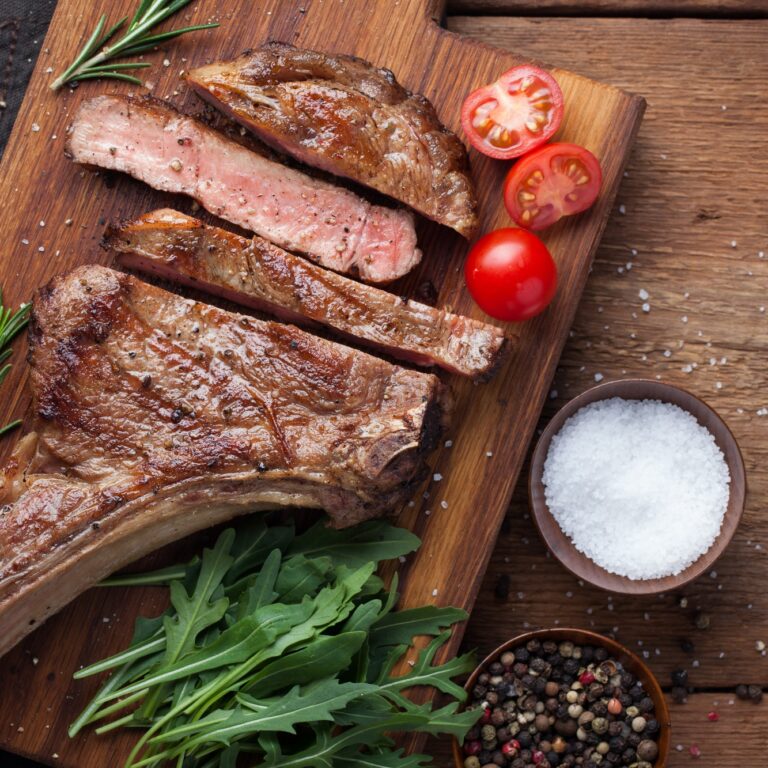
Dear moms and parents! April here helping you relax into motherhood from my tropical island home.
Today I bring some island shortcuts to a classic Pinoy comfort food – nilagang buto buto ng baka or beef soup made simple for busy moms. In the world of Filipino cuisine, few dishes can compare to the comforting and heartwarming taste of Nilagang Baka. This humble dish also perfectly illustrates how time-saving strategies can transform complex recipes into manageable kitchen joy.
The Best Ingredients For Your Nilagang Buto Buto ng Baka
Nilagang Baka, which translates to “boiled beef,” is a very flavorful dish that embodies the essence of Filipino cooking. It becomes Nilagang Buto Buto because it includes the beef neck bones or “buto”. The beauty of this beef soup lies in its simplicity, using only a handful of ingredients that come together to create a truly satisfying dish. The primary components of this flavorful beef soup include:
a) Beef: For your Nilagang Baka, tough cuts of beef slowly cooked to perfection, are the star of this dish. The meat is responsible for the rich and robust flavor that permeates the broth during the slow cooking process. For the richest, most soul-satisfying nilagang baka, begin with cuts of beef high in collagen and connective tissue. Meaty bones, tendons, shanks, and necks packed with cartilage yield a broth that’s deep in flavor and mouthfeel.
As the tough cuts slowly simmer, their collagen and elastin fibers break down, releasing gelatin and amino acids that thicken and enrich the stock. Choose beef ribs, short ribs, brisket or cross-cut chuck roast for the deepest, most intense beefy flavor.
b) Vegetables: The soup is generously filled with an assortment of fresh vegetables, such as potatoes, corn on the cob, saba bananas, green beans, and cabbage. These vegetables add both flavor, texture and nutritional value to the dish.
•Potatoes – Whether red or white, cubed potatoes are a must for your nilagang baka. Their starch helps thicken the broth as they cook, absorbing the rich beefy flavors. You may substitute sweet potatoes (kamote). Though this is more usually used for Sinigang, it can work well in a pinch,
•Cabbage – The mild taste of cabbage pairs perfectly with the robust beef flavors. I like to add wedges of green cabbage towards the end of cooking so they remain crisp-tender. You may replace this with pechay. Perfect for your condiment of patis and calamansi later!
•String beans or Baguio beans- Local sitaw or Baguio beans add a pop of color and texture to Nilagang baka. I like to add them after the potatoes to ensure they’re tender but still have some bite. My mom prefers them soft and it can be a bit chewy for elders so be mindful of this when cooking your nilagang baka.
•Carrots – Slivers of orange carrot bring vibrancy and natural sweetness to the stew. They also tend to cook slightly faster, so watch them carefully. The Tagalog version doesn’t have carrots so it;s your choice if you;re gonna put them. Some people don;t like them because it makes the Nilagang baka a bit sweetish.
•Corn – Whether fresh cob or kernel corn, a few pieces add a juicy, summery touch to offset the richness of the beef and broth.
•Leafy greens – Pechay, spinach, kangkong, or chili leaves may be added as well. They wilt down within minutes, absorbing the smoky, beefy flavor of the broth. I add them right at the end just to wilts the greens. These are not traditional but it doesn’t alter the taste in any way.
c) Peppercorns: Whole black peppercorns infuse the broth with a mild heat, enhancing the overall taste of the soup.
d) Fish Sauce or Salt: Filipino cuisine often incorporates fish sauce, locally known as “patis,” to add depth and umami to dishes. In the absence of fish sauce, simple table salt can be used as an alternative.
Traditionally, Nilagang Baka’s preparation may take time. It is a labor of love that yields a nourishing and satisfying meal. When I was young and up to now, Sundays on the island means getting up early and buying beef for a hearty Sunday lunch.
But thank God for modern conveniences, now I can cook this beef soup in an hour.
Cook your Nilagang Buto Buto ng Baka in Pressure Cooker
My easy Nilagang Baka starts with submerging cubed beef and bone-in neck pieces in cold water to draw out impurities.
Place the beef in a pressure cooker with just enough water to cover, along with onions, peppercorns, fish sauce, and ehemm, Knorr beef cubes. It’s as simple as that!
Once the pressure cooker comes to a boil, lock the lid and cook for about 45 minutes – or just until the meat is fall-apart tender.
At this point, you can quickly add vegetables – cubed potatoes and corn cooked first followed by string beans, cabbage and other vegetables you want to add. Allow to boil again for just a few minutes to ensure the veggies remain crisp-tender.
The end result? Fall-off-the-bone beef, fragrant broth and perfectly cooked mixed vegetables – all achieved in half the usual time.
This modernized method brings the rustic, soul-soothing comfort of Nilagang Baka to families seeking faster, good-enough home cooking – using minimal effort tuned to 21st century lifestyles.
Nilagang Buto Buto ng Baka in Pressure Cooker Recipe
Ingredients
Shopping List
- 1/2 kilo beef buto buto (bone in beef neck)
- 1/2 kilo beef cubes
- 2 medium potatoes, quartered
- 1 small cabbage, cut into wedges
- 100 grams green beans, trimmed
- 2 corn on the cob cut in 3 parts (optional)
- 2 ripe saba bananas cut into 3 parts (optional)
From your Pantry
- water (enough to cover beef)
- 1 large onion, quartered
- 2 tsp ground black pepper
- 1 beef cube
- 1 tbsp fish sauce
- Salt to taste
Tools:
- Pressure cooker, dutch oven or large pot
- Slotted spoon or skimmer
Instructions
- Submerge beef in a pot of cold water for about 30 minutes to let the blood out.
- Place combined beef in a pressure cooker with enough water to cover. Cover partially but do not lock. Bring to a boil over medium heat and .skim off any foam.
- Stir in onion, pepper, fish sauce. Lock pressure cooker cover and allow to boil.
- Once you hear the whistle,, reduce heat and simmer gently up to 45 minutes until meat is tender.
- Turn fire off and let steam out for about 5 minutes before opening cover.
- Turn fire back on and add potatoes and corn (if using). Cook 5 minutes until potatoes are almost tender.
- Add green beans, bananas (if using) and cabbage. Cook 2 to 4 minutes until vegetables are tender-crisp.
- Serve with rice and patis with calamansi dip on the side.
Notes
Make it better with: Chili crisp or chili oil drizzled on top.
For Vegetarians:
Substitute soy curls or ground seitan for shank meat and omit tendons.
You can replace cabbage with Pechay and Baguio beans with string beans (sitaw) for an even more traditional taste.
Corn and saba are optional because it tends to sour the soup which I don't like.
If not using pressure cooker, cook beef soup for at least 1 1/2 hours up to 2 hours.
Tags

Hello! I am April
...I don't know exactly what a prayer is. I do know how to pay attention, how to fall down. into the grass, how to kneel down in the grass, how to be idle and blessed, how to stroll through the fields, which is what I have been doing all day. Tell me, what else should I have done? Doesn't everything die at last, and too soon? Tell me, what is it you plan to do with your one wild and precious life?
- That Summer Day. Mary Oliver Tweet











